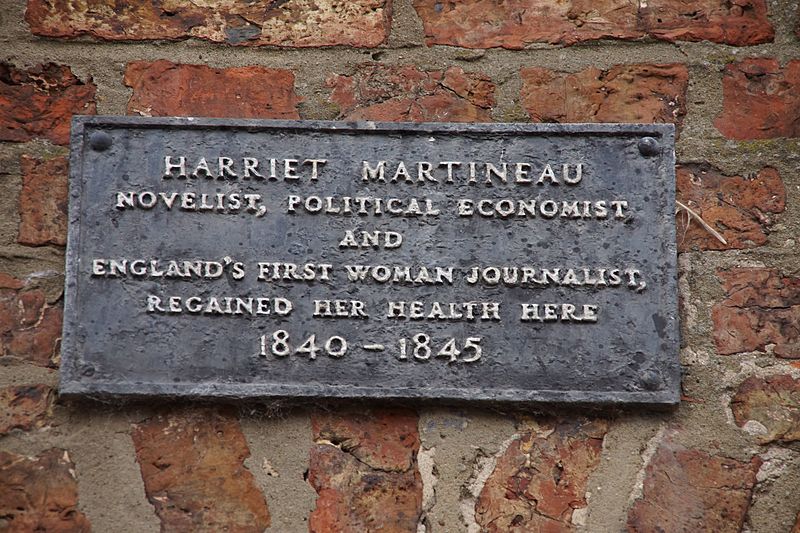Image: Harriet Martineau plaque - Tynemouth

Description: Harriet Martineau was born on 12th June 1802. "Novelist, Political Economist and England's First Woman Journalist Regained Her Health here 1840 -1845." She died on 27th June 1876. "Newcastle and Tynemouth - In 1839, during a visit to Continental Europe, Martineau was diagnosed with a uterine tumour. She several times visited her brother-in-law, Thomas Michael Greenhow, who was a celebrated doctor in Newcastle upon Tyne, to try to alleviate her symptoms. On the last occasion she stayed for six months in the Greenhow family house at 28 Eldon Square. Immobile and confined to a couch, she was cared for by her mother until purchasing a house and hiring a nurse to aid her. She next moved downriver to Tynemouth, where she stayed at Mrs Halliday's boarding-house, 57 Front Street, for nearly five years from 16 March 1840. The establishment is still open as a guest house today, now named the "Martineau Guest House" in her honour. The critic Diana Postlethwaite wrote of this period for Martineau: Being homebound is a major part of the process of becoming feminine. In this interior setting she (Martineau) is taught the home arts of working, serving, and cleaning, as well as the rehearsals for the role of mothering. She sees her mother... doing these things. They define femininity for her. Her illness caused her to literally enact the social constraints of women during this time. Martineau wrote a number of books during her illness, and a historical plaque marks this house. In 1841 she published a series of four novels for children, The Playfellow, comprising The Settlers at Home, The Peasant and the Prince, Feats on the Fiord, and The Crofton Boys. In 1844 she published Life in the Sickroom: Essays by an Invalid, an autobiographical reflection on invalidism. She wrote Household Education (1848), the handbook on the "proper" way to raise and educate children. Lastly, she began working on her autobiography. Completed much later, it included some hundred pages on this period. Notable visitors included Richard Cobden and Thomas and Jane Carlyle. Life in the Sickroom is considered to be one of Martineau's most under-rated works. It upset evangelical readers as they "thought it dangerous in 'its supposition of self-reliance'". This series of essays embraced traditional womanhood. Martineau dedicated it to Elizabeth Barrett, as it was "an outpouring of feeling to an idealized female alter ego, both professional writer and professional invalid- and utterly unlike the women in her own family". Written during a kind of public break from her mother, this book was Martineau's proclamation of independence. At the same time, Martineau turned the traditional patient–doctor relationship on its head by asserting control over her space even in sickness. The sickroom was her space. Life in the Sickroom explained how to regain control even in illness. Alarmed that a woman was suggesting such a position in the power dynamic, critics suggested that, as she was an invalid, her mind must also be sick and the work was not to be taken seriously. British and Foreign Medical Review dismissed Martineau's piece on the same basis as the critics: an ill person cannot write a healthy work. They thought it was unheard of for a woman to suggest being in a position of control, especially in sickness. Instead, the Review recommended that patients follow "unconditional submission" to the advice of doctors. They disagreed with the idea that Martineau might hold any sort of "authority to Britain's invalids". Expecting to remain an invalid for the rest of her life, Martineau delighted in the new freedom of views using her telescope. Across the Tyne was the sandy beach ″where there are frequent wrecks—too interesting to an invalid... and above the rocks, a spreading heath, where I watch troops of boys flying their kites; lovers and friends taking their breezy walks on Sundays..." She expressed a lyrical view of Tynemouth: When I look forth in the morning, the whole land may be sheeted with glittering snow, while the myrtle-green sea swells and tumbles... there is none of the deadness of winter in the landscape; no leafless trees, no locking up with ice; and the air comes in through my open upper sash brisk, but sun-warmed. The robins twitter and hop in my flower-boxes... And at night, what a heaven! What an expanse of stars above, appearing more steadfast, the more the Northern Lights dart and quiver! During her illness, she for a second time declined a pension on the civil list, fearing to compromise her political independence. After publication of her letter on the subject, some of her friends raised a small annuity for her soon after. In 1844 Martineau underwent a course of mesmerism, returning to health after a few months. There was national interest in mesmerism at this time. Also known as 'animal magnetism', it can be defined as a "loosely grouped set of practices in which one person influenced another through a variety of personal actions, or through the direct influence of one mind on another mind. Mesmerism was designed to make invisible forces augment the mental powers of the mesmeric object." She eventually published an account of her case in sixteen Letters on Mesmerism, which caused much discussion. Her work led to friction with "the natural prejudices of a surgeon and a surgeon's wife" (i.e., her brother-in-law, Thomas Michael Greenhow and her sister, Elizabeth Greenhow, née Martineau)." wikipedia
Title: Harriet Martineau plaque - Tynemouth
Credit: https://www.flickr.com/photos/bolckow/22008351586/
Author: Bolckow
Usage Terms: Creative Commons Attribution-Share Alike 2.0
License: CC BY-SA 2.0
License Link: https://creativecommons.org/licenses/by-sa/2.0
Attribution Required?: Yes
Image usage
The following page links to this image:

